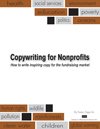A great blog post by Augie Ray of Forrester Research compares the risk avoidance of using social media to life insurance and flat tires.
A common lament among marketers – within the nonprofit and for-profit sectors – is that the social media is hard to measure. Your true ROI (Return on Investment) is unknown. Whether it’s the marketer or their boss, there’s hesitation to invest time and resources on a partially “fuzzy” marketing channel.
And by “fuzzy” I refer to the inability to measure a precise ROI on every social media activity. Augie Ray points out that there are many results that can be measured. But don’t scale down or avoid areas of social media just because the measurement is sketchy or unavailable. Doing this puts you at risk.
In Augie’s words:
“Much of the results generated by Social Media can be measured quantitatively and qualitatively . . . But some of the advantages from Social Media cannot be measured, because much like investments in insurance and tires, the benefits come from risk avoidance.
Let me ask you a personal question: In 2009, what was the ROI of your investment in life insurance? The vast majority of you paid your premiums and filed no claims (or you wouldn’t be reading this). You received a negative ROI, so clearly that means you’re suspending your life insurance in 2010, correct?
Social Media is like corporate reputation insurance. You pay premiums in the form of building relationships, listening, responding, creating widgets, and building communities.”
The benefits from your “social media insurance” are several-fold. They include risk avoidance and . . .
- Stronger relationships with your donors and members
- The ability to rally your followers and fans immediately when needed. Haiti disaster relief is an example for charities. Advocacy is another as you rally your supporters (donors or members) to act fast on a breaking news story.
- Heaven forbid there’s ever a scandal of fraud or corruption within your organization. But if so, with social media you have multiple channels in which to be completely open and honest about the issue – transparency. You can get the word out within a few minutes! All this dampens long-term negative effects of the scandal.
- And you can monitor the social media channels to see what people – not only your own fans and followers but everyone – are talking about. What matters most to them? This allows you to understand their perspective more clearly and write marketing and fundraising messages that connect strongly with your audience. It helps you avoid the risk of being ignored or worse, losing your donors or members.
- For charities, a scandal within a large national or international organization (e.g., Salvation Army, Red Cross, United Way), has a negative ripple effect on the entire nonprofit sector. So if you’re well known in social media circles you can immediately point out what you’re doing to insure that doesn’t happen to your organization. You can help avoid the negative backlash for your charity.
- Proper use of social media (i.e., it’s definitely NOT all about you) can help you acquire more donors and members, and it can empower them to also build your nonprofit. They can be extremely effective fundraisers and recruiters.
Read the Forrester blog post for more insights on social media and risk avoidance.
